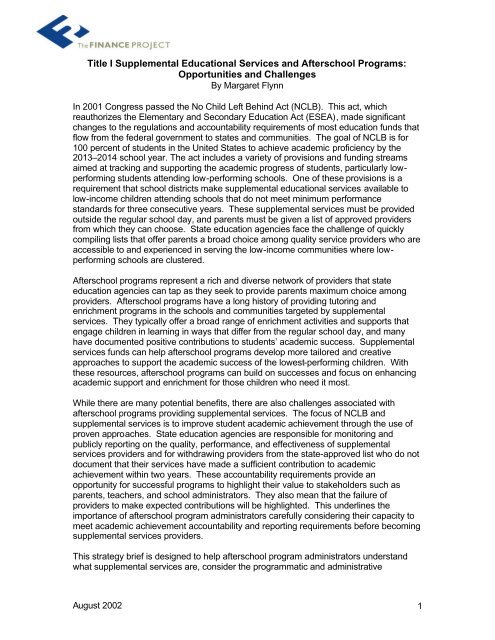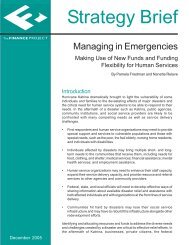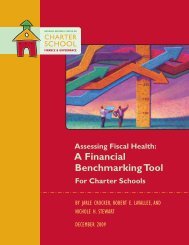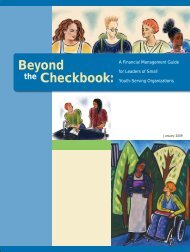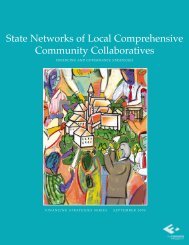Title I Supplemental Educational Services and Afterschool Programs ...
Title I Supplemental Educational Services and Afterschool Programs ...
Title I Supplemental Educational Services and Afterschool Programs ...
Create successful ePaper yourself
Turn your PDF publications into a flip-book with our unique Google optimized e-Paper software.
<strong>Title</strong> I <strong>Supplemental</strong> <strong>Educational</strong> <strong>Services</strong> <strong>and</strong> <strong>Afterschool</strong> <strong>Programs</strong>:<br />
Opportunities <strong>and</strong> Challenges<br />
By Margaret Flynn<br />
In 2001 Congress passed the No Child Left Behind Act (NCLB). This act, which<br />
reauthorizes the Elementary <strong>and</strong> Secondary Education Act (ESEA), made significant<br />
changes to the regulations <strong>and</strong> accountability requirements of most education funds that<br />
flow from the federal government to states <strong>and</strong> communities. The goal of NCLB is for<br />
100 percent of students in the United States to achieve academic proficiency by the<br />
2013–2014 school year. The act includes a variety of provisions <strong>and</strong> funding streams<br />
aimed at tracking <strong>and</strong> supporting the academic progress of students, particularly lowperforming<br />
students attending low-performing schools. One of these provisions is a<br />
requirement that school districts make supplemental educational services available to<br />
low-income children attending schools that do not meet minimum performance<br />
st<strong>and</strong>ards for three consecutive years. These supplemental services must be provided<br />
outside the regular school day, <strong>and</strong> parents must be given a list of approved providers<br />
from which they can choose. State education agencies face the challenge of quickly<br />
compiling lists that offer parents a broad choice among quality service providers who are<br />
accessible to <strong>and</strong> experienced in serving the low-income communities where lowperforming<br />
schools are clustered.<br />
<strong>Afterschool</strong> programs represent a rich <strong>and</strong> diverse network of providers that state<br />
education agencies can tap as they seek to provide parents maximum choice among<br />
providers. <strong>Afterschool</strong> programs have a long history of providing tutoring <strong>and</strong><br />
enrichment programs in the schools <strong>and</strong> communities targeted by supplemental<br />
services. They typically offer a broad range of enrichment activities <strong>and</strong> supports that<br />
engage children in learning in ways that differ from the regular school day, <strong>and</strong> many<br />
have documented positive contributions to students’ academic success. <strong>Supplemental</strong><br />
services funds can help afterschool programs develop more tailored <strong>and</strong> creative<br />
approaches to support the academic success of the lowest-performing children. With<br />
these resources, afterschool programs can build on successes <strong>and</strong> focus on enhancing<br />
academic support <strong>and</strong> enrichment for those children who need it most.<br />
While there are many potential benefits, there are also challenges associated with<br />
afterschool programs providing supplemental services. The focus of NCLB <strong>and</strong><br />
supplemental services is to improve student academic achievement through the use of<br />
proven approaches. State education agencies are responsible for monitoring <strong>and</strong><br />
publicly reporting on the quality, performance, <strong>and</strong> effectiveness of supplemental<br />
services providers <strong>and</strong> for withdrawing providers from the state-approved list who do not<br />
document that their services have made a sufficient contribution to academic<br />
achievement within two years. These accountability requirements provide an<br />
opportunity for successful programs to highlight their value to stakeholders such as<br />
parents, teachers, <strong>and</strong> school administrators. They also mean that the failure of<br />
providers to make expected contributions will be highlighted. This underlines the<br />
importance of afterschool program administrators carefully considering their capacity to<br />
meet academic achievement accountability <strong>and</strong> reporting requirements before becoming<br />
supplemental services providers.<br />
This strategy brief is designed to help afterschool program administrators underst<strong>and</strong><br />
what supplemental services are, consider the programmatic <strong>and</strong> administrative<br />
August 2002 1
implications of becoming a provider, <strong>and</strong> identify the steps needed to become a<br />
successful provider. Readers should keep in mind that the provision of supplemental<br />
services is a new requirement <strong>and</strong> state education agencies are currently in the process<br />
of defining criteria <strong>and</strong> selecting supplemental services providers for the 2002–2003<br />
school year. Thus, considerations outlined in this brief are preliminary, based on the No<br />
Child Left Behind Act, draft guidance from the U.S. Department of Education, <strong>and</strong> early<br />
state efforts at implementation. They are meant to provide an initial underst<strong>and</strong>ing of<br />
supplemental services, which will evolve as implementation moves forward. Section I<br />
provides background information on the No Child Left Behind Act <strong>and</strong> the provisions<br />
related to supplemental services. Section II provides initial steps that programs<br />
interested in becoming providers can take, <strong>and</strong> Section III explores specific requirements<br />
<strong>and</strong> considerations related to supplemental services.<br />
I. Background<br />
To underst<strong>and</strong> the opportunities <strong>and</strong> challenges associated with supplemental services,<br />
it is helpful to underst<strong>and</strong> the context of supplemental services in the No Child Left<br />
Behind Act. The provisions of NCLB build on the 1994 reauthorization of ESEA, which<br />
required each state to develop content st<strong>and</strong>ards, assessments, <strong>and</strong> definitions of<br />
adequate yearly progress. NCLB goes a step further than previous efforts by imposing<br />
real consequences <strong>and</strong> requirements on the use of federal funds for those schools that<br />
fail to document adequate progress among the children they serve. The act requires<br />
state <strong>and</strong> local education agencies to:<br />
Clearly define “academic proficiency,” by developing st<strong>and</strong>ards;<br />
Set yearly objectives for meeting those st<strong>and</strong>ards, based on how much progress<br />
the lowest-performing demographic groups or schools must make annually to<br />
reach a proficient level of achievement at the end of 12 years (adequate yearly<br />
progress);<br />
Measure student progress toward those st<strong>and</strong>ards through annual assessments<br />
(states must design <strong>and</strong> administer reading <strong>and</strong> math tests to all students in<br />
grades three through eight by 2005; by 2007, students will also be tested in<br />
science); <strong>and</strong><br />
Implement a series of intervention <strong>and</strong> remediation measures for students <strong>and</strong><br />
schools that are not making adequate yearly progress (the provision of<br />
supplemental services is one of these interventions).<br />
Which schools must provide targeted intervention <strong>and</strong> remediation services, what<br />
services they must provide, <strong>and</strong> when they must provide them are dictated by whether<br />
schools are making adequate yearly progress, as measured by assessments. Schools<br />
that fail to meet the state’s definition of adequate yearly progress for two consecutive<br />
years are classified as schools in need of improvement. Each of these schools must<br />
develop a comprehensive plan for improving student performance <strong>and</strong> offer students the<br />
option of transferring to another public school, in the same district, that is not in schoolimprovement<br />
status. If the school still does not make adequate yearly progress after<br />
one year in school-improvement status (i.e., after failing to make adequate yearly<br />
progress for three consecutive years), the school district must fund supplemental<br />
educational services for low-income students.<br />
August 2002 2
Funding <strong>and</strong> implementation of the school choice <strong>and</strong> supplemental services provisions<br />
described above are closely linked (for more information on funding, see the box<br />
“<strong>Supplemental</strong> <strong>Services</strong>: The Basics”). Students who choose to transfer out of a school<br />
in improvement status are not offered supplemental services. Thus, the number of<br />
students offered supplemental services will depend, in part, on how many students are<br />
offered the option <strong>and</strong> choose to transfer out of schools in improvement status. In<br />
districts in which multiple schools are in improvement status, or in which schools not in<br />
improvement status have little capacity to accept additional students, local education<br />
agencies will have to direct more funding toward supplemental services. In these cases,<br />
the U.S. Department of Education encourages local educational agencies to offer<br />
supplemental educational services during the first year of school-improvement status. 1<br />
The local education agency must continue to make school choice <strong>and</strong> supplemental<br />
services available until the school has made adequate yearly progress for two<br />
consecutive years. These provisions also apply to schools that were not making<br />
adequate yearly progress as defined under the 1994 reauthorization. Thus,<br />
implementation of supplemental services will begin in the fall of 2002 for some schools. 2<br />
1 U.S. Department of Education, No Child Left Behind, <strong>Supplemental</strong> <strong>Educational</strong> <strong>Services</strong> Draft Non-<br />
Regulatory Guidance (Washington, D.C.: U.S. Department of Education, August 6, 2002) 8.<br />
2 As of August 2002, the U.S. Department of Education estimates that over 7,000 schools will have to begin<br />
providing supplemental services in the 2002–2003 school year. (U.S. Department of Education,<br />
“<strong>Supplemental</strong> <strong>Services</strong>,” 2002); available at www.nclb.gov.<br />
August 2002 3
<strong>Supplemental</strong> <strong>Services</strong>: The Basics<br />
What is the purpose? To ensure that students increase their academic achievement,<br />
particularly in reading/language arts <strong>and</strong> mathematics. Instruction must take place outside<br />
the regular school day (before or after school, on weekends, or during the summer) <strong>and</strong><br />
may include assistance such as tutoring, remediation, <strong>and</strong> academic intervention.<br />
Who is eligible for supplemental services? Within <strong>Title</strong> I schools that have not made<br />
adequate yearly progress for three consecutive years, children from low-income families<br />
are eligible for supplemental services. If more students request services than the district<br />
can fund, the district must place priority on the lowest-achieving low-income students.<br />
Who can provide services? A variety of private nonprofit or for-profit entities, as well as<br />
local education agencies <strong>and</strong> individual schools, are eligible to provide supplemental<br />
services, * as long as they have a demonstrated record of effectiveness in increasing<br />
academic achievement <strong>and</strong> are capable of providing supplemental education services<br />
consistent with the state’s academic st<strong>and</strong>ards.<br />
How will supplemental service providers be selected? State education agencies are<br />
responsible for defining what constitutes a “demonstrated record of effectiveness” <strong>and</strong><br />
selection criteria for providers. Once they have established the criteria for selecting<br />
providers, state education agencies are responsible for creating a list of providers in<br />
consultation with parents, teachers, school districts, <strong>and</strong> interested providers. They also<br />
may use a request for proposals to identify supplemental services providers. The list of<br />
providers must be updated annually, but a state may choose to update the list more<br />
frequently. Parents of students eligible for supplemental services will receive the list of<br />
providers from which they can choose.<br />
How much funding is available for supplemental services? The amount available per<br />
child for eligible children is the lesser of the <strong>Title</strong> I, Part A, allocation per child to the local<br />
education agency (LEA) or the actual cost of the services. The allocation per child of <strong>Title</strong> I<br />
funds to LEAs varies widely across the nation, ranging from roughly $600 to $1,500. **<br />
The total amount that local education agencies will have available to spend on<br />
supplemental services is tied to what they spend on transportation for school choice. LEAs<br />
are required to spend 20 percent of <strong>Title</strong> I allocations on both choice-related transportation<br />
<strong>and</strong> supplemental services (unless the LEA can meet all dem<strong>and</strong>s for choice <strong>and</strong><br />
supplemental services with a lesser amount). Of this 20 percent, a minimum of 5 percent<br />
must be spent on supplemental services (unless all requests for supplemental services can<br />
be met with a lesser amount). The remaining 15 percent can be spent on either<br />
transportation for school choice or supplemental services, so more funding will be made<br />
available for supplemental services in districts in which less is spent on transportation for<br />
school choice.<br />
* According to draft regulatory policy published by the U.S. Department of Education, local<br />
education agencies or individual schools in school-improvement, corrective action, or restructuring<br />
status may not provide supplemental services.<br />
** U.S. Department of Education, No Child Left Behind, <strong>Supplemental</strong> <strong>Educational</strong> <strong>Services</strong> Draft<br />
Non-Regulatory Guidance (Washington, D.C.:U.S. Department of Education, August 6, 2002) 28.<br />
August 2002 4
II. Steps to Becoming a <strong>Supplemental</strong> <strong>Services</strong> Provider<br />
This section outlines initial steps that afterschool program administrators interested in<br />
becoming supplemental services providers should take.<br />
• The first step is to determine whether schools in your community will be required<br />
to provide supplemental services, <strong>and</strong> to identify your state’s criteria for<br />
supplemental services providers. To obtain this information, contact your state<br />
education agency’s <strong>Title</strong> I director. The National Association of <strong>Title</strong> I Directors<br />
has a listing of state <strong>Title</strong> I directors at<br />
http://www.titlei.org/Contacts/contact_directors.html. In addition, most state<br />
education agencies have information about supplemental services <strong>and</strong><br />
applications to become providers available online. The <strong>Afterschool</strong> Alliance<br />
includes links to state applications for supplemental services on their<br />
supplemental services page at www.afterschoolalliance.org/supp_main.cfm.<br />
• As you review which schools are required to provide supplemental services in<br />
your state, consider the option of providing supplemental services to a broader or<br />
different subsection of children or schools than you currently serve. If you have<br />
the capacity <strong>and</strong> can address transportation issues (local education agencies<br />
may use <strong>Title</strong> I funds to pay for transportation to supplemental services, but they<br />
do not have to), you can provide supplemental services to children from<br />
neighboring schools, districts, <strong>and</strong> towns.<br />
• If you find that your state’s initial application period has already closed, find out<br />
when the state plans to take applications again <strong>and</strong> prepare for this date.<br />
According to NCLB, states must update their list of supplemental services<br />
providers annually, but they may choose to do so more often. If a state does not<br />
receive enough applications in the initial process, it may choose to release<br />
another request for proposals.<br />
• When responding to your state’s criteria, consider how you can build on or<br />
exp<strong>and</strong> existing collaborations. Effectively collaborating <strong>and</strong> communicating with<br />
school administrators, teachers, <strong>and</strong> parents is essential to the provision of<br />
supplemental services, <strong>and</strong> having their full partnership may help you meet<br />
reporting requirements. Other partners, such as universities, might also be<br />
helpful in developing effective strategies for the provision of supplemental<br />
services.<br />
• Remember that state education agencies have considerable discretion in<br />
designing the criteria <strong>and</strong> the process that they will use to select supplemental<br />
services providers. Because this is new work for states, state education<br />
agencies have not necessarily finalized their processes <strong>and</strong> may be more open<br />
to feedback or more willing to be flexible than usual. Call your state education<br />
agency’s <strong>Title</strong> I office <strong>and</strong> ask questions or pose possible alternatives if you are<br />
filling out an application for supplemental services <strong>and</strong> there are criteria that are<br />
difficult for you to meet.<br />
August 2002 5
III. <strong>Afterschool</strong> <strong>Programs</strong> <strong>and</strong> <strong>Supplemental</strong> <strong>Services</strong>: Considerations<br />
While the purpose <strong>and</strong> target of supplemental services closely align with the work of<br />
many afterschool programs, the funding comes with considerable accountability<br />
requirements <strong>and</strong> administrative implications. <strong>Afterschool</strong> programs interested in<br />
becoming supplemental services providers should carefully <strong>and</strong> realistically consider<br />
these implications. This section summarizes relevant requirements <strong>and</strong> considerations<br />
in two critical areas: administration <strong>and</strong> organization; <strong>and</strong> program content <strong>and</strong><br />
documentation of effectiveness.<br />
Keep in mind, as you review these considerations, that your state’s criteria <strong>and</strong> decisions<br />
are the bottom line in terms of the requirements related to supplemental services.<br />
Considerations Related to Administration <strong>and</strong> Organization<br />
<strong>Supplemental</strong> services funding is structured differently than other funding streams that<br />
afterschool programs typically use to support their services. Many afterschool programs,<br />
particularly those serving low-income communities, rely heavily on grants from public<br />
<strong>and</strong> private sources. Grants are typically disbursed in a lump sum to serve certain<br />
purposes <strong>and</strong> populations. <strong>Supplemental</strong> services funding is different, however, in that<br />
the dollars are attached only to eligible children <strong>and</strong> follow those children to whatever<br />
provider the parents choose. This structure implies a host of considerations related to<br />
how afterschool programs will h<strong>and</strong>le administrative <strong>and</strong> reporting requirements. These<br />
considerations are related to funding; planning <strong>and</strong> reporting; <strong>and</strong> outreach <strong>and</strong><br />
marketing.<br />
Funding: Underst<strong>and</strong>ing Amounts <strong>and</strong> Duration<br />
The funding structure for supplemental services will require afterschool programs to<br />
track <strong>and</strong> report on funds in a way they may not be accustomed to. First of all, funding<br />
will be less predictable than grant funds in several dimensions. Even if afterschool<br />
program administrators can obtain an estimate of the number of students who are<br />
eligible for supplemental services in their community, they will not know how many<br />
parents will choose their program as a provider. Furthermore, the funding for<br />
supplemental services is based on whether the school is making adequate yearly<br />
progress. If students in the school improve their performance <strong>and</strong> the school makes<br />
adequate yearly progress for two consecutive years, the local education agency will no<br />
longer be required to provide supplemental services. <strong>Afterschool</strong> programs should<br />
consider these issues, particularly if they plan to alter their program structure or add staff<br />
in order to provide supplemental services. Program developers might consider more<br />
flexible arrangements, such as extending the hours of existing staff (rather than hiring<br />
new) or using consultants to provide additional staffing for supplemental services.<br />
Provision of supplemental services is essentially structured as a fee-for-service program.<br />
This means that local education agencies can choose to disburse payment for<br />
supplemental services when or even after those services are rendered. <strong>Afterschool</strong><br />
program administrators should make sure they underst<strong>and</strong> their local education<br />
agency’s system <strong>and</strong> schedule for paying for supplemental services <strong>and</strong> be prepared to<br />
cover operating costs, in the event that there is a gap between provision of <strong>and</strong> payment<br />
for services. In addition, afterschool programs applying to become supplemental<br />
services providers will have to provide state education agencies with the cost of their<br />
services. <strong>Afterschool</strong> program administrators must carefully consider additional costs<br />
August 2002 6
associated with meeting the content <strong>and</strong> reporting requirements of supplemental<br />
services when developing their cost of services. This section outlines a variety of costs<br />
to consider related to supplemental services.<br />
Planning <strong>and</strong> Reporting<br />
<strong>Supplemental</strong> services providers must develop specific achievement goals <strong>and</strong><br />
individual plans for affecting the academic achievement of the students they serve.<br />
They must also regularly report to parents, teachers, <strong>and</strong> the local education agency on<br />
each student’s progress. In the case of students with disabilities, the plan must be<br />
consistent with the student’s individualized education program. The specific reporting<br />
schedule <strong>and</strong> requirements will be established by state <strong>and</strong> local educational agencies<br />
<strong>and</strong> will vary from place to place. <strong>Afterschool</strong> programs should carefully consider the<br />
planning <strong>and</strong> reporting requirements in their community <strong>and</strong> make a realistic assessment<br />
of how much staff time they will need to allocate to meet those requirements.<br />
Outreach <strong>and</strong> Marketing<br />
According to NCLB, local education agencies are responsible for informing parents of<br />
their children’s eligibility for supplemental services <strong>and</strong> for providing parents with a list of<br />
providers (compiled by the state education agency) from which to choose. <strong>Afterschool</strong><br />
programs serving schools required to provide supplemental services can also act as a<br />
resource, helping parents underst<strong>and</strong> what supplemental services are <strong>and</strong> helping<br />
parents of eligible children negotiate the local education agency’s procedures for<br />
accessing supplemental services. The Web sites of the U.S. Department of Education’s<br />
No Child Left Behind (www.nclb.gov) <strong>and</strong> the <strong>Afterschool</strong> Alliance<br />
(www.afterschoolalliance.org) have materials aimed at helping parents underst<strong>and</strong><br />
supplemental services.<br />
In addition, afterschool programs that are included on the list of supplemental services<br />
providers should consider how they will market their services to parents. <strong>Programs</strong> may<br />
wish to adapt or exp<strong>and</strong> existing marketing materials to reflect the specific supports <strong>and</strong><br />
services they will make available to children eligible for supplemental services. This will<br />
Administration <strong>and</strong> Organization—Questions to Consider<br />
How will you comply with administrative <strong>and</strong> data reporting requirements?<br />
How much staff time will be needed to develop plans <strong>and</strong> document <strong>and</strong> report<br />
progress?<br />
What will complying with these requirements cost?<br />
What are the potential benefits?<br />
How significant <strong>and</strong> how sustainable do you expect supplemental services<br />
dollars to be?<br />
- How many students in your community will be eligible for supplemental<br />
services?<br />
- How close to making adequate yearly progress is the school or district<br />
you serve?<br />
- Who else might provide supplemental services (i.e., who is your<br />
competition)?<br />
How will you reach out to parents who are seeking providers?<br />
Do you already have a relationship with these parents?<br />
How will you convince parents that you are the most appropriate provider<br />
(particularly parents who may already be using your program for free)?<br />
August 2002 7
e particularly important for programs that may already be serving children eligible for<br />
supplemental services. These programs will need to make it clear to parents what their<br />
children will receive in terms of enhanced or more targeted services than they had been<br />
receiving without supplemental services funds.<br />
Considerations related to program content <strong>and</strong> documentation of effectiveness<br />
NCLB is focused on proven approaches <strong>and</strong> accountability for results. It includes<br />
requirements for supplemental services providers related to the content of their services<br />
<strong>and</strong> the documentation of their progress toward results. This section discusses three<br />
issues related to the content of supplemental services <strong>and</strong> the documentation of<br />
effectiveness that afterschool programs should consider: demonstrating effectiveness;<br />
aligning content with academic st<strong>and</strong>ards; <strong>and</strong> delivering supplemental services.<br />
Demonstrating effectiveness<br />
To become a provider of supplemental services, afterschool programs must document a<br />
demonstrated record of effectiveness in increasing the academic proficiency of students.<br />
Each state agency decides what documentation is required to demonstrate<br />
effectiveness. In draft guidance on supplemental services, the U.S. Department of<br />
Education encourages states to be flexible in their criteria for demonstrating<br />
effectiveness, stating: “The statutory emphasis on the state’s responsibility to promote<br />
participation by the maximum number of providers to give parents as many choices as<br />
possible suggests that States take a flexible approach in determining effectiveness.” 3<br />
When considering how to respond to their state’s criteria for demonstrating<br />
effectiveness, afterschool program administrators should keep in mind that there are a<br />
variety of ways to document effects on academic proficiency. While state education<br />
agencies will probably place higher value on data such as comparative performance on<br />
academic assessments, they may be willing to accept other types of evidence, such as<br />
teacher, student, or parent surveys; attendance rates; homework completion; or written<br />
testimony by parents or teachers.<br />
Program administrators who have not gathered information regarding effects on<br />
academic achievement or who plan to use supplemental services funding to implement<br />
new strategies might also, depending on the criteria of their state education agency, use<br />
existing research on the effect of strategies or approaches that they employ. NCLB<br />
emphasizes supplemental services approaches that are supported by academic<br />
research. In recent years, the U.S Department of Education has invested significantly in<br />
efforts to determine the most effective approaches to promote success in reading, math,<br />
<strong>and</strong> science <strong>and</strong> to summarize <strong>and</strong> disseminate that information to educators. In<br />
addition, a developing body of information is available from afterschool programs that<br />
are documenting successes in contributing to academic achievement.<br />
3 U.S. Department of Education, No Child Left Behind, 14.<br />
August 2002 8
Research on Effective Strategies for Promoting Academic Achievement<br />
Sources Focusing on Effective <strong>Educational</strong> Approaches<br />
The National Reading Panel is a panel of experts that has completed a comprehensive<br />
review of research assessing the effectiveness of different approaches used to teach<br />
children to read. Their report <strong>and</strong> related information is on their Web site at<br />
www.nationalreadingpanel.org.<br />
The Department of Education Office of <strong>Educational</strong> Research <strong>and</strong> Improvement<br />
(www.ed.gov/offices/OERI) administers funds supporting a number of research <strong>and</strong><br />
dissemination projects, including:<br />
- The National Center for Improving Student Learning <strong>and</strong> Achievement in<br />
Mathematics <strong>and</strong> Sciences, www.wcer.wisc.edu/ncisla; <strong>and</strong><br />
- The National Institute on the Education of At-Risk Students,<br />
www.ed.gov/offices/OERI/At-Risk.<br />
The OERI Web site includes information <strong>and</strong> links to the above institutes <strong>and</strong> to a wide<br />
variety of other education research sources, including the Regional Education Labs.<br />
Sources Focusing on the Effectiveness of <strong>Afterschool</strong> <strong>Programs</strong><br />
The Harvard Family Research Project has an online database of evaluations of<br />
afterschool programs that can be searched according to criteria, such as academic<br />
outcomes, at www.gse.harvard.edu/~hfrp.<br />
Once programs gain approval to provide supplemental services, they are responsible for<br />
documenting their contribution to student academic achievement on an ongoing basis.<br />
State education agencies will develop a process for monitoring <strong>and</strong> publicly reporting the<br />
effectiveness of providers of supplemental services <strong>and</strong> for withdrawing approval from<br />
providers that fail, for two consecutive years, to contribute to increasing the academic<br />
proficiency of students. NCLB does not specify how much supplemental services<br />
providers are expected to contribute to academic proficiency or how that contribution<br />
should be measured, but the general emphasis in NCLB is on measuring academic<br />
proficiency through student assessments. State education agencies are likely to use<br />
student test scores to measure the effectiveness of supplemental services. This<br />
underlines the importance of underst<strong>and</strong>ing what contribution to academic proficiency<br />
your state education agency expects supplemental services providers to make <strong>and</strong> how<br />
they will measure that contribution, <strong>and</strong> then making a realistic assessment of whether<br />
you can meet these requirements. Carefully consider whether your services can make<br />
the difference in academic achievement expected by your state education agency, <strong>and</strong><br />
what meeting documentation requirements <strong>and</strong> developing data collection tools <strong>and</strong><br />
systems will cost in terms of additional staff time.<br />
Aligning content with academic st<strong>and</strong>ards<br />
Providers of supplemental services have to align their instruction <strong>and</strong> content with state<br />
academic st<strong>and</strong>ards. Draft guidance notes that the instructional content <strong>and</strong> methods of<br />
supplemental services providers do not have to be identical to those of the LEA, but they<br />
August 2002 9
must share the same focus. 4 <strong>Afterschool</strong> programs interested in becoming supplemental<br />
services providers should review their state’s st<strong>and</strong>ards <strong>and</strong> consider whether their<br />
academic enrichment <strong>and</strong> support services align with the st<strong>and</strong>ards. Most state<br />
education agencies publish their st<strong>and</strong>ards on their Web pages. Program administrators<br />
who want to develop curriculum that is more closely aligned with their state’s st<strong>and</strong>ards<br />
could begin by networking with other afterschool programs <strong>and</strong> building on efforts that<br />
others have made to integrate state st<strong>and</strong>ards into the afterschool curriculum.<br />
Delivering <strong>Supplemental</strong> <strong>Services</strong><br />
While NCLB places a great deal of emphasis on accountability for results <strong>and</strong> reporting,<br />
it allows providers considerable flexibility in how they actually design <strong>and</strong> deliver<br />
services. <strong>Afterschool</strong> program administrators who seek to become supplemental<br />
services providers face a number of decisions related to staffing <strong>and</strong> delivering these<br />
services.<br />
Mode of instruction—<strong>Supplemental</strong> services can be provided through one-on-one<br />
tutoring, small-group tutoring, technology-based approaches, or other educational<br />
interventions, so long as they are based on research, designed to increase academic<br />
achievement, <strong>and</strong> consistent with the instructional program of the local education<br />
agency <strong>and</strong> the state st<strong>and</strong>ards.<br />
Intensity of services—There are no federal requirements regarding the intensity of<br />
supplemental services. Providers have to decide how many hours per week they will<br />
provide supplemental services. NCLB requires providers to commit to providing<br />
supplemental services until the end of the school year in which services were first<br />
provided. However, guidance from the U.S. Department of Education acknowledges<br />
that, depending on the intensity of services, the funding levels per pupil may limit<br />
services to a shorter timeframe. In making decisions about intensity of services,<br />
afterschool program administrators should consider how supplemental services<br />
would align with their existing program schedule.<br />
Location of services <strong>and</strong> transportation—<strong>Afterschool</strong> administrators should consider<br />
whether their location is accessible to students <strong>and</strong> parents <strong>and</strong>, if applicable,<br />
whether current transportation arrangements could h<strong>and</strong>le additional students or<br />
accommodate varying schedules.<br />
<strong>Afterschool</strong> program administrators will have to make decisions regarding the above<br />
issues with a dual focus on what makes sense, given the context <strong>and</strong> capacity of their<br />
existing program, as well as what experience <strong>and</strong> research indicate are the most<br />
effective ways to support the academic proficiency of students. Some programs will<br />
need to make few or no changes to their existing services in order to meet the<br />
requirements of supplemental services. For these programs, providing supplemental<br />
services will mainly involve reaching out to <strong>and</strong> integrating eligible students into their<br />
existing program, <strong>and</strong> meeting reporting requirements. Other programs may need to<br />
integrate new approaches that are more closely aligned with research <strong>and</strong> state<br />
st<strong>and</strong>ards <strong>and</strong> instruction <strong>and</strong> may need to decrease staff-student ratios in order to<br />
assess <strong>and</strong> address students’ individual learning needs. Before making changes to<br />
program content, structure, or staffing, program administrators should carefully weigh<br />
the benefits of providing supplemental services against the potential challenges related<br />
4 U.S. Department of Education, No Child Left Behind, 15.<br />
August 2002 10
Program Content <strong>and</strong> Documentation of Effectiveness—Questions to Consider<br />
Is providing targeted assistance to contribute to the academic success of lowincome,<br />
low-performing students in line with the mission of your program?<br />
Do data that you have collected in the past, or does your experience, lead you<br />
to believe that you will be successful in affecting the academic achievement of<br />
targeted low-performing students?<br />
Will you have to change or adapt your program to effectively provide<br />
supplemental services to targeted students?<br />
What will these changes mean in terms of, for example, curriculum<br />
development or staffing?<br />
What are the estimated costs of these changes?<br />
What are the potential benefits, in terms of new revenue for your program <strong>and</strong><br />
the development of enhanced supports <strong>and</strong> services to increase the academic<br />
success of low-achieving students?<br />
If you do not currently have the capacity to provide supplemental services,<br />
can you partner with existing providers of tutoring services in your<br />
community?<br />
How will you comply with requirements to document an effect on academic<br />
proficiency of the students you serve within two years?<br />
to the disruption of the existing program, the strict accountability requirements, <strong>and</strong> the<br />
uncertainty of the duration of funding.<br />
Program administrators who are wary of making significant changes to their program in<br />
order to provide supplemental services might consider developing partnerships with<br />
providers of tutoring services in the community. In many communities, individuals or<br />
programs provide tutoring services on a contractual basis. <strong>Afterschool</strong> programs <strong>and</strong><br />
tutors could devise arrangements in which afterschool programs take responsibility for<br />
administering supplemental services funds, marketing the services to parents, <strong>and</strong><br />
providing an accessible space; <strong>and</strong> tutors develop the individualized student<br />
achievement plans <strong>and</strong> provide services.<br />
Conclusion<br />
In many communities, afterschool programs are providing a wide range of services to<br />
support the success of students. <strong>Supplemental</strong> services funding can help afterschool<br />
programs develop, exp<strong>and</strong>, <strong>and</strong> improve their capacity to contribute to the school<br />
success of the lowest-performing students in the lowest-performing schools. It also<br />
provides an opportunity for afterschool programs to better document <strong>and</strong> draw attention<br />
to their successes. As they must with all funding sources, however, afterschool program<br />
administrators should carefully consider how this funding fits in with their overall mission<br />
<strong>and</strong> program <strong>and</strong> whether they have the capacity to comply with the requirements of<br />
supplemental services. Those afterschool programs with the desire <strong>and</strong> capacity to<br />
provide supplemental services will greatly contribute to the range of quality, accessible<br />
supplemental educational services options for students.<br />
August 2002 11
Helpful Resources<br />
U. S. Department of Education<br />
The Web site for No Child Left Behind (www.nclb.gov) contains links to the No Child Left<br />
Behind Act; the proposed rules <strong>and</strong> draft guidance published on August 6, 2002;<br />
information for parents; <strong>and</strong> other information related to supplemental services <strong>and</strong><br />
NCLB.<br />
<strong>Afterschool</strong> Alliance<br />
The <strong>Afterschool</strong> Alliance maintains a supplemental services page on its Web site<br />
(www.afterschoolalliance.org/supp_main.cfm) that includes links to state applications for<br />
supplemental services providers <strong>and</strong> fact sheets on supplemental services for providers<br />
<strong>and</strong> parents.<br />
Council of Chief State School Officers<br />
The council of Chief State School Officers has published a Toolkit on <strong>Supplemental</strong><br />
<strong>Services</strong> developed jointly with the Education Quality Institute. It is aimed at helping<br />
State Education Agencies to underst<strong>and</strong> <strong>and</strong> implement supplemental services <strong>and</strong><br />
includes a sample application <strong>and</strong> checklist for supplemental service providers, as well<br />
as recommendations for the process of approving supplemental service providers. The<br />
toolkit <strong>and</strong> other information on supplemental services is available on the CCSSO<br />
website at http://www.ccsso.org/nclb.html.<br />
Education Commission of the States<br />
The Education Commission of the States has published a number of helpful papers<br />
analyzing the No Child Left Behind Act, including briefs on low-performing schools <strong>and</strong><br />
school choice. These <strong>and</strong> other resources are on the Commission’s Web site at<br />
www.ecs.org.<br />
National Conference of State Legislatures<br />
The National Conference of State Legislatures maintains a No Child Left Behind Web<br />
page that includes a summary of NCLB, states' consolidated plans, <strong>and</strong> links to relevant<br />
publications resources at www.ncsl.org/programs/educ/NoChild.htm.<br />
National Governors Association<br />
The National Governors Association maintains a No Child Left Behind Web page that<br />
includes analysis <strong>and</strong> summaries related to supplemental services at<br />
www.nga.org/center/topics/1,1188,D_3308,00.html.<br />
Acknowledgments<br />
The author would like to extend sincere<br />
appreciation to Sharon Deich at The Finance<br />
Project, Victoria Wegener from the <strong>Afterschool</strong><br />
Alliance, Judy Kaplan from the North Central<br />
Regional <strong>Educational</strong> Laboratory, <strong>and</strong> Theresa<br />
Clarke from the National Governors<br />
Association for reviewing <strong>and</strong> providing useful<br />
feedback on this brief.<br />
The Finance Project<br />
The Finance Project provides a range of<br />
tools <strong>and</strong> materials related to financing<br />
<strong>and</strong> sustaining out-of-school time<br />
programs. “Using <strong>Title</strong> I to Support Outof-School<br />
Time <strong>and</strong> Community School<br />
Initiatives,” in addition to other strategy<br />
briefs <strong>and</strong> funding guides, can be found<br />
at www.finaceproject.org/osthome.htm.<br />
August 2002 12


